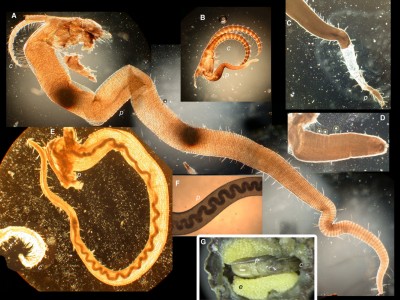NSU Newsroom
SharkBytes
Horizons
This version of NSU News has been archived as of February 28, 2019. To search through archived articles, visit nova.edu/search. To access the new version of NSU News, visit news.nova.edu.
This version of SharkBytes has been archived as of February 28, 2019. To search through archived articles, visit nova.edu/search. To access the new version of SharkBytes, visit sharkbytes.nova.edu.
NSU Researcher Discovers Unique Anatomical Characteristic in Barnacle Study
Turns Out Barnacle Penises Are Truly Amazing Appendages
FOR IMMEDIATE RELEASE
FORT LAUDERDALE/DAVIE, Fla. – When it comes to long distance relationships, it seems the barnacle has it all figured out. That’s because if they fancy a mate who is far away, the male can simply make his penis longer to meet the need.
That’s right – unlike humans, barnacles have the ability to physically change the size and length of their penis.
You may be asking yourself “how does one study such a thing?”
According to NSU associate professor J. Matthew Hoch, Ph.D., barnacles have long-fascinated scientists and studying them has helped the development of scientific theories from evolution and natural selection to systematics and taxonomy. What is being learned from barnacles continues to contribute to a new understanding of “reproductive biology, life history, phenotypic plasticity and sex allocation theory.” In fact, studying barnacles goes all the way back to someone synonymous with the science of evolution.
“Research into barnacle mating dates back to Charles Darwin – they were a major interest of his before he published The Origin of Species,” said Dr. Hoch, a researcher in NSU’s Halmos College of Natural Sciences and Oceanography.
In fact, in 1857, after hearing of an acquaintance who had actually observed mating barnacles, Darwin wrote:
‘I am anxious to know whether this recipient was a willing agent or adulterer. or whether it was a case of rape by act. If the recipient was in full vigour [sic], I think it wd [sic] be impossible to insert anything without its consent.
Yours sincerely, C. Darwin
Dr. Hoch and co-authors Daniel Schneck, who was an NSU undergraduate student during the study (he’s since earned his Bachelor’s in marine biology,) and Christopher Neufeld, Ph.D. who was at Quest University Canada, had their research paper recently published in the journal Integrative and Comparative Biology.
The trio studied something that is unique to the barnacle – depending on environmental circumstances, they can change the shape of the male sexual organ. It turns out that barnacles, those marine animals that many find annoying or a nuisance as they tend to grow on the hulls of boats, dock pilings and other items, can actually change their penises.
Dr. Hoch said that based on their size, barnacles have the largest penises of all animals. And if that wasn’t enough for bragging rights, this research shows that these animals can change the shape, size, length and girth of the organ, all of which is to best suit the environment they are in.
“For many [barnacle] species, the condition of the penis changes seasonally,” Dr. Hoch and his colleagues said in their paper. “In the most extreme circumstances, it degenerates and is shed during the first post-mating molt and is re-grown for the next mating season.”
So the next time you have to have the hull of your boat or the pilings on your dock cleaned of barnacles, you might want to show a little more respect for these creatures. After all, it seems they can do something humans have wanted to do since nearly the dawn of time.
You can ready the full research paper HERE.
Be sure to sign up for NSU’s RSS feed so you don’t miss any of our news releases, guest editorials and other announcements. Please sign up HERE.
###
About Nova Southeastern University (NSU): Located in beautiful Fort Lauderdale, Florida, Nova Southeastern University (NSU) is a dynamic research institution dedicated to providing high-quality educational programs at the undergraduate, graduate, and first-professional degree levels. A private, not-for-profit institution with more than 26,000 students, NSU has campuses in Fort Lauderdale, Fort Myers, Jacksonville, Miami, Miramar, Orlando, Palm Beach, and Tampa, Florida, as well as San Juan, Puerto Rico, while maintaining a presence online globally. For more than 50 years, NSU has been awarding degrees in a wide range of fields, while fostering groundbreaking research and an impactful commitment to community. Classified as a research university with “high research activity” by the Carnegie Foundation for the Advancement of Teaching, NSU is 1 of only 50 universities nationwide to also be awarded Carnegie’s Community Engagement Classification, and is also the largest private, not-for-profit institution in the United States that meets the U.S. Department of Education’s criteria as a Hispanic-serving Institution. Please visit www.nova.edu for more information about NSU and realizingpotential.nova.edu for more information on the largest fundraising campaign in NSU history.
About NSU’s Halmos College of Natural Sciences and Oceanography: The college provides high-quality undergraduate (bachelor’s degree) and graduate (master’s and doctoral degrees and certificates) education programs in a broad range of disciplines, including marine sciences, mathematics, biophysics, and chemistry. Researchers carry out innovative basic and applied research programs in coral reef biology, ecology, and geology; fish biology, ecology, and conservation; shark and billfish ecology; fisheries science; deep-sea organismal biology and ecology; invertebrate and vertebrate genomics, genetics, molecular ecology, and evolution; microbiology; biodiversity; observation and modeling of large-scale ocean circulation, coastal dynamics, and ocean atmosphere coupling; benthic habitat mapping; biodiversity; histology; and calcification. The college’s newest building is the state-of-the-art Guy Harvey Oceanographic Center, an 86,000-square-foot structure filled with laboratories; offices; seminar rooms; an auditorium; and indoor and outdoor running sea water facilities. Please visit cnso.nova.edu for more information.
July 26, 2016
Joe Donzelli | Office of Public Affairs
954-262-2159 (office) | 954-661-4571 (cell)
jdonzelli@nova.edu | www.nova.edu
